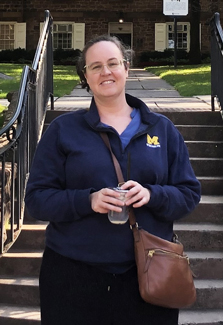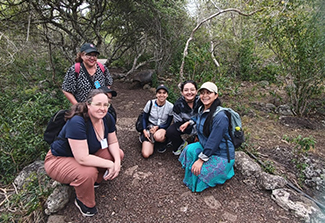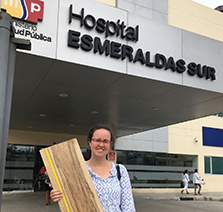Improving child & teen health in Peru and Kenya
July/August 2025 | Volume 24 Number 4

Iquitos, Peru, is often described as the largest city in the world that's inaccessible by road, says Gwenyth Lee, PhD, assistant professor in the Department of Biostatistics and Epidemiology at the Rutgers School of Public Health. “So if you take a big boat up the Amazon, this is about as far as you can go before the river gets a lot shallower and you have to switch to a small boat.” Situated east of the Andes in Loreto province, it is home to more than 150,000 people and served as a major port in the global rubber trade during the 19th Century.
“All of my formative research—master's, PhD, postdoc—has been in the general area of early child health,” says Lee, who lived in Iquitos on and off for more than two years while working on her PhD. “Spending that amount of time there allowed me to make certain connections to child health and become interested in questions based on observations or discussions with people.”
Iquitos, then, was a natural setting for her Fogarty LAUNCH Fellowship.
Investigative independence
Lee’s project examined the impact of enteric (intestinal) infections on growth and development of a cohort of children in Iquitos. Specifically, she looked at how enteric infections, and other exposures related to nutrition, impact child growth and development. Her work used social network analysis to evaluate how social ties within communities function to improve food security.
The project allowed her to continue her research in a familiar field, yet it also enabled her to transition to nutritional epidemiology, which examines child development in relation to diet, a field of interest to Lee. “My fellowship was very much a building block, scientifically, to the projects that I work on now.”
Her Fogarty project also pushed her towards independence. “Field work wasn't completely new to me, but what was new is that, increasingly, I was left to figure out what I wanted to do and then run with it.” She also managed her own administrative paperwork, a significant advance. “It was the first project where I had a large number of people working directly for me—during my PhD, I had two people helping me collect data, for the Fogarty project, eight or 10. My mentors started to, in an appropriate way, step back and make me more responsible as a project manager.”
Results of her fellowship year also include publications, presentations, and landing a post-doctoral position. One of her papers has been well-cited in Peru and served as the basis for lectures at Universidad Peruana Cayetano Heredia (UPCH) and the Peruvian Instituto Nacional de Salud. “Being in-country was very helpful for finding those opportunities and networking and disseminating my research more readily.” She continued working with her Peruvian colleagues at UPCH during her post-doc training funded by Fogarty’s Inter-American Training for Innovations in Emerging Infectious Diseases program.
Subsequently, she began a research faculty position at University of Michigan School of Public Health, where she received a K01 award from the National Institute of Allergy and Infectious Diseases. Her Ecuador-based project, Dynamic modeling of antagonism between enteric infection and undernutrition in infancy, officially ended in May but continues under a no-cost extension. “I work as a co-investigator with Dr. Joseph Eisenberg and Dr. Karen Levy for
Enteropatógenos, Crecimiento, Microbioma, y Diarrea (EcoMiD), a pediatric cohort study that looks at environmental exposures and child health outcomes with a specific focus on the microbiome across rural and urban communities in Ecuador.” (The microbiome is the community of microorganisms that can be found living together in your gut.)
 Photo courtesy of Gwenyth LeeLee and members of Equipo de Nutrición Universidad San Francisco de Quito gather in Galapagos.
Photo courtesy of Gwenyth LeeLee and members of Equipo de Nutrición Universidad San Francisco de Quito gather in Galapagos.
Eat well, live well
Offered a position at Rutgers University, Lee transferred and began working with another early career investigator, Shauna Downs, an associate professor in the Department of Health Behavior, Society and Policy. Combining interests, they received funding from the
Eunice Kennedy Shriver National Institute of Child Health and Human Development for a
project in Kenya that aims to reduce teen malnutrition.
The local teens helped name the project,
Dishi fiti Ishi fiti, which means
eat well, live well. Lee examines how teens make dietary choices and how their environments affect those decisions. “We have a certain kind of food environment here in the U.S., and if you want to know how to modify that to improve choices, you need to look across a lot of systems to understand some of the broader principles at play.” Already, Lee has seen how teens receive messages about westernized foods being “aspirational.” Still, they understand that traditional food—what their grandmothers cook—has great worth. “There's room for a counter-narrative about what's valuable and good in what they already have.”
One year into that project, Lee has begun to steer students and colleagues to apply for a LAUNCH fellowship. “It’s invaluable for people interested in research, especially global health research, but even research in general.”
 Photo courtesy of Gwenyth LeeLee outside Hospital Esmeraldas in Ecuador
Photo courtesy of Gwenyth LeeLee outside Hospital Esmeraldas in Ecuador
A sense of direction
As an undergrad, Lee enjoyed the book-learning aspects of chemistry, but once she progressed to the laboratory, she began to lose interest. “I'm a little distractible and I like to do lots of different things, so the focus that was necessary for the lab—pipetting each aliquot precisely—I was always struggling to perform basic tasks at the level of my fellow classmates.” Unfortunately, this realization came only after she’d been accepted into a few chemistry PhD programs. She says, smiling, “So I joined the Peace Corps (as one does) to try to give myself time and space to do something meaningful, while I figured out what it was that I was good at and wanted to do.”
She served as a math-science education volunteer in northwest Cameroon, where she met volunteers enrolled in a special program that paired a master’s degree in public health with an internship in the Peace Corps. “They worked in hospitals and other healthcare settings. Their training allowed them to be useful in a more specialized way than I was able as a person with a more general education.” Returning to the states, she abandoned chemistry to study global health at Johns Hopkins University and never looked back.
The fruits of global health research recompense Americans in two ways, says Lee. “It provides training opportunities for American students while advancing general scientific knowledge.”
One example of this is her Ecuador project. “It's increasingly understood that the American microbiome is affected by our diets and exposures to our environment. Now that is not necessarily representative of the way humans have lived for thousands of years, right?” Researchers who study the microbiome in Ecuador encounter an urban-to-rural gradient, with part of the population eating a more westernized diet and living a more westernized lifestyle, while the diet and lifestyle of river communities, including residents of Iquitos, reflect regional traditions.
“So there's a variety there that would be hard to find in the U.S. And we can learn from that and potentially apply lessons learned back in the States.”
More information
Updated August 25, 2025
To view Adobe PDF files,
download current, free accessible plug-ins from Adobe's website.
Related Fogarty Programs
Related World Regions / Countries
Related Global Health Research Topics